
While only one digit separates the two models, the reality is that there’s a pile of differences. Many big-ticket differences (like Training Readiness), but also lots of little and more nuanced differences. The last time I did this type of post, I identified 65+ differences between the Forerunner 965 and Epix. This time, I’m going to try and maintain my sanity and focus on the big ticket ones, and then keep a simple running list of the remainder. That seems more viable.
Update: I failed. In total, I’ve got roughly around 107+ differences detailed. But in reality, for the upper section of this post I’m consolidating things into big groups to keep them simple (versus the reality the Training Status is multiple underlying features). Yet, in the sport profile section alone we’ve got 37 differences. Sorry-not-sorry.
With that, let’s just get straight into it, starting off with one I wouldn’t count, the price. There are effectively two models of each watch, albeit, in different ways:
Garmin Forerunner 165 (base): $249USD
Garmin Forerunner 165 (music edition): $299USD
Garmin Forerunner 265S: $449USD
Garmin Forerunner 265: $449USD
In the case of the Forerunner 165, the inclusion of offline music capability (which also includes WiFi connectivity) costs an extra $50. Whereas for the Forerunner 265, it’s included on all models. Instead, that model has two different sizes. So, let’s start with the sizes.
1) Display & Size Differences
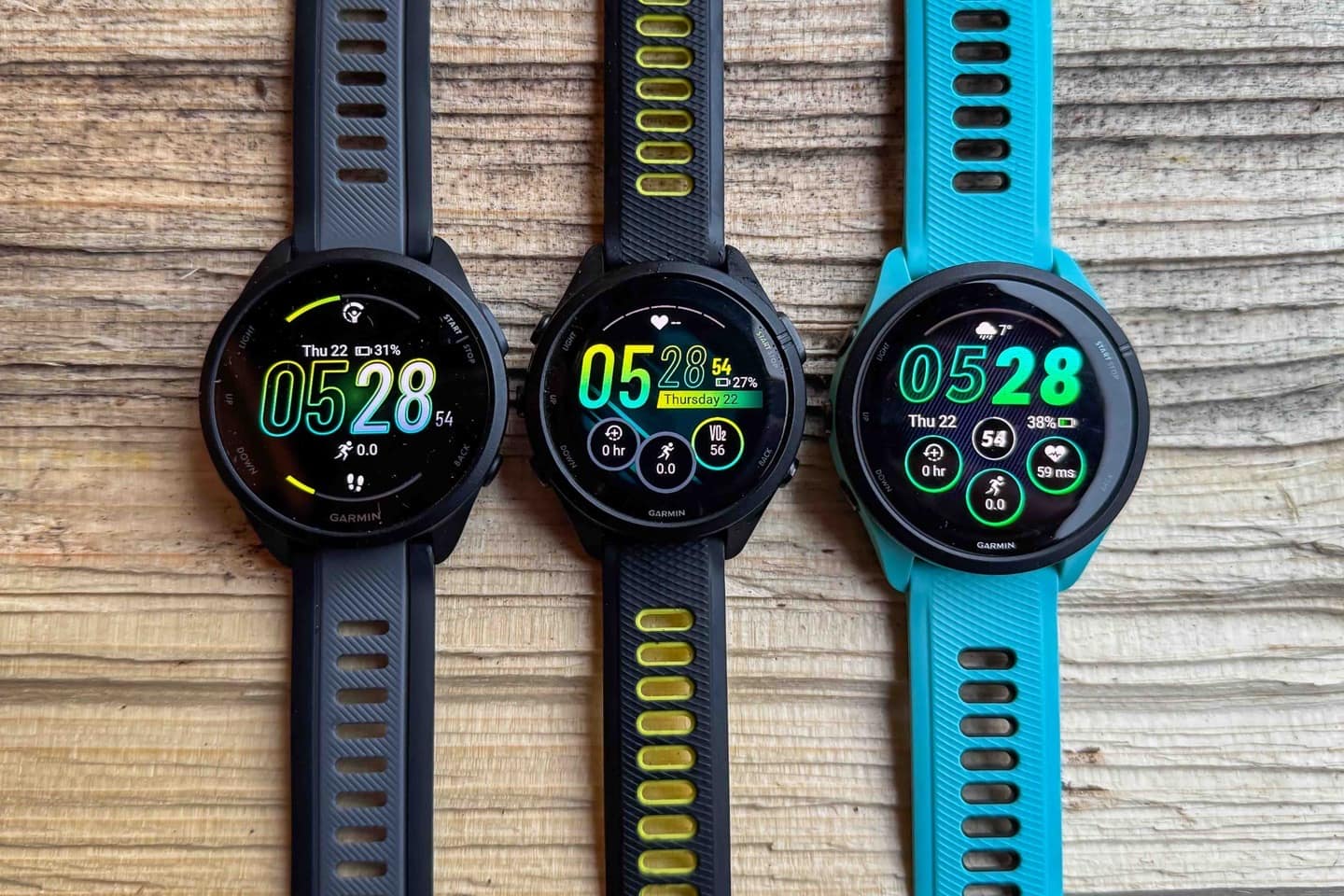
There are effectively three different-sized watches here, including three different display sizes.
Forerunner 165: 1.2” (390×390 pixels)
Forerunner 265S: 1.1” (360×360 pixels)
Forerunner 265: 1.3” (416×416 pixels)
What’s interesting though, as I’ll cover in the battery section, is that the smaller Forerunner 265S actually gets longer battery life than the larger Forerunner 265, because they use the same battery in both models, but the smaller display means it draws less battery life.
When it comes to the physical size of the units, they are effectively considered the following case sizes by Garmin:
Forerunner 165: 43mm
Forerunner 265S: 42mm
Forerunner 265: 46mm
That said, while the 165 is only 1mm bigger than the FR265S, for some reason the FR265S feels notably smaller on the wrist than the FR165. Said differently, as a tall dude, the FR265S felt pretty tiny on my wrist, whereas the FR165 feels more normal.
From a glass/display standpoint, the FR265 has a slightly curved glass surface (technically the last little bit is curved), whereas the FR165 is flat across.
Forerunner 165 glass type: “Chemically strengthened glass”
Forerunner 265/265S glass type: Corning Gorilla Glass 3
And finally, weight-wise:
Forerunner 165: 39g
Forerunner 265S: 39g
Forerunner 265: 47g
Phew, let’s leave spec lists behind, and get into the features.
2) Training Readiness
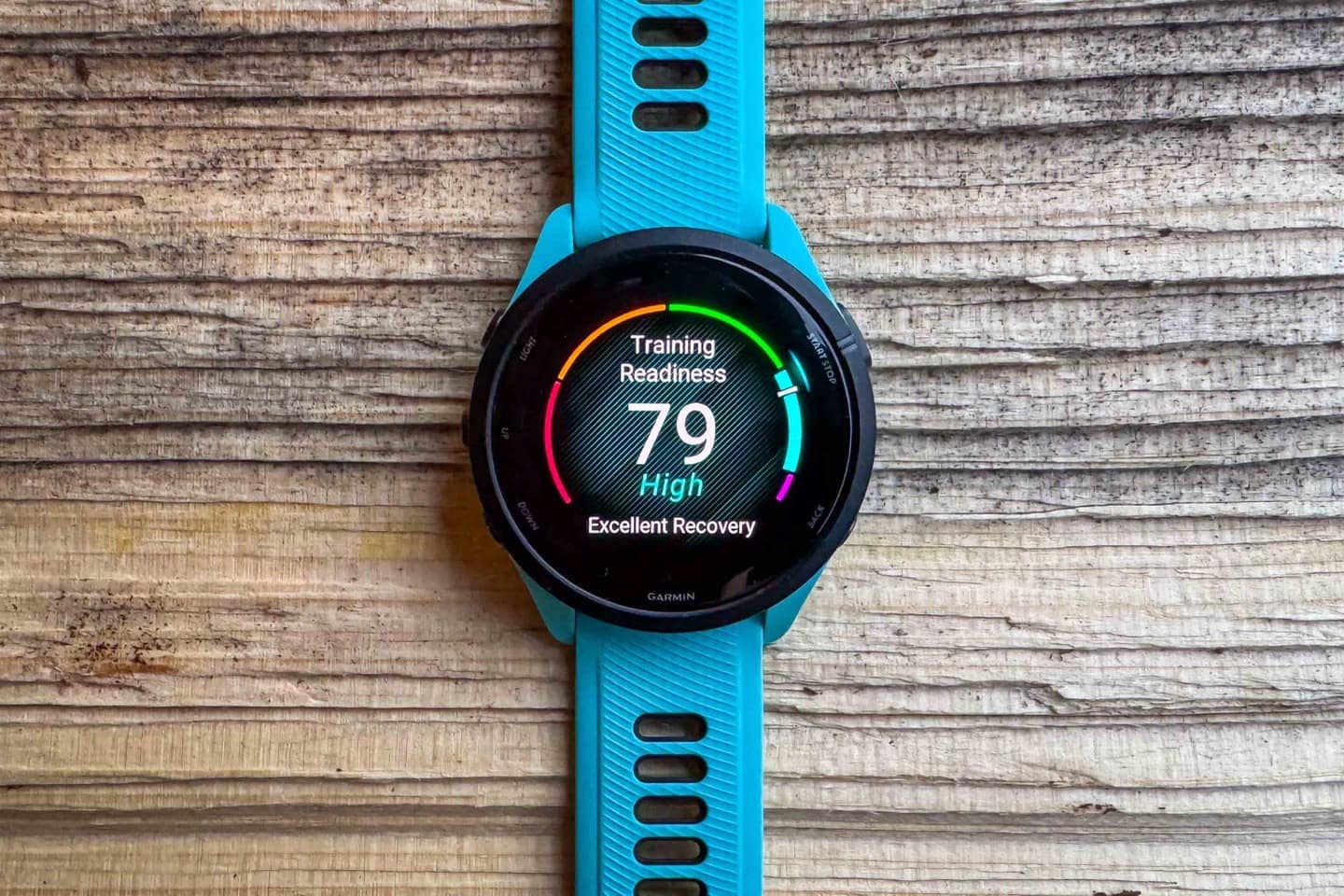
The single biggest software difference, by far, is the lack of Training Readiness on the Forerunner 165. Training Readiness is Garmin’s umbrella score that encapsulates a suite of metrics that measure training load and recovery, and give you a constantly moving score as to how “ready to train” you are at any point in the day.
Each morning when you wake up you’ll see a score, which includes your night’s sleep data, HRV data, but also your recent training load and recovery data. Let’s say that score is 55 (out of 100), that’d be a ‘good enough’ score in the eyes of Garmin. Now, a few hours later around lunch, you’re ready to workout. By now your score might be 65, because you had a relaxing morning without much stress. But once you go out for that hard run, your score will drop down to perhaps 20, because your ‘readiness to train’ again, is now lower.
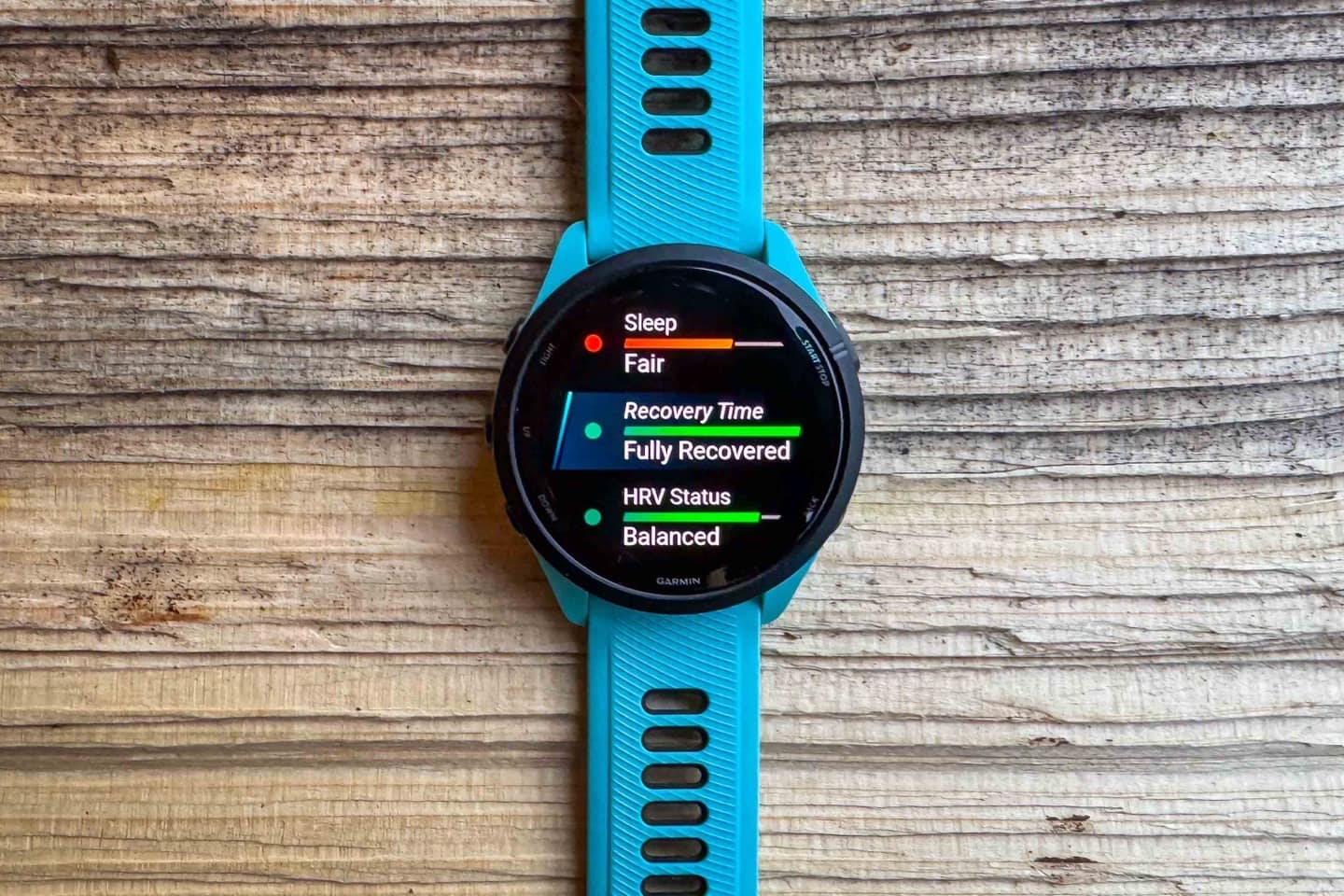
The score has six core components it leverages and weights differently:
– Sleep: This one is specifically looking at last night’s sleep
– Recovery time: This looks at your Recovery time from last workout, in hours
– HRV Status: This is comparing your 7-day trend versus historical trend
– Acute Load: This is looking at your 7-day trend
– Sleep History: This is looking at last night versus your prior 2 nights of sleep history
– Stress History: This is looking at the 3 days of daytime data (excluding overnight readings)
I’d argue that Training Readiness is one of Garmin’s most well-executed features in many years. It doesn’t mean though that you need to follow it to the letter, but I do find it’s a good gut check againt training too much, or when too fatigued. Equally, if I find myself for days in the 70-80’s, then it’s likely I’m on a well-deserved vacation from everything. :)
Training Readiness is not available on the Forerunner 165, though it is available on Garmin’s Instinct 2 series devices, which are now the same price as the Forerunner 165 Music, at $299.
3) Training Status
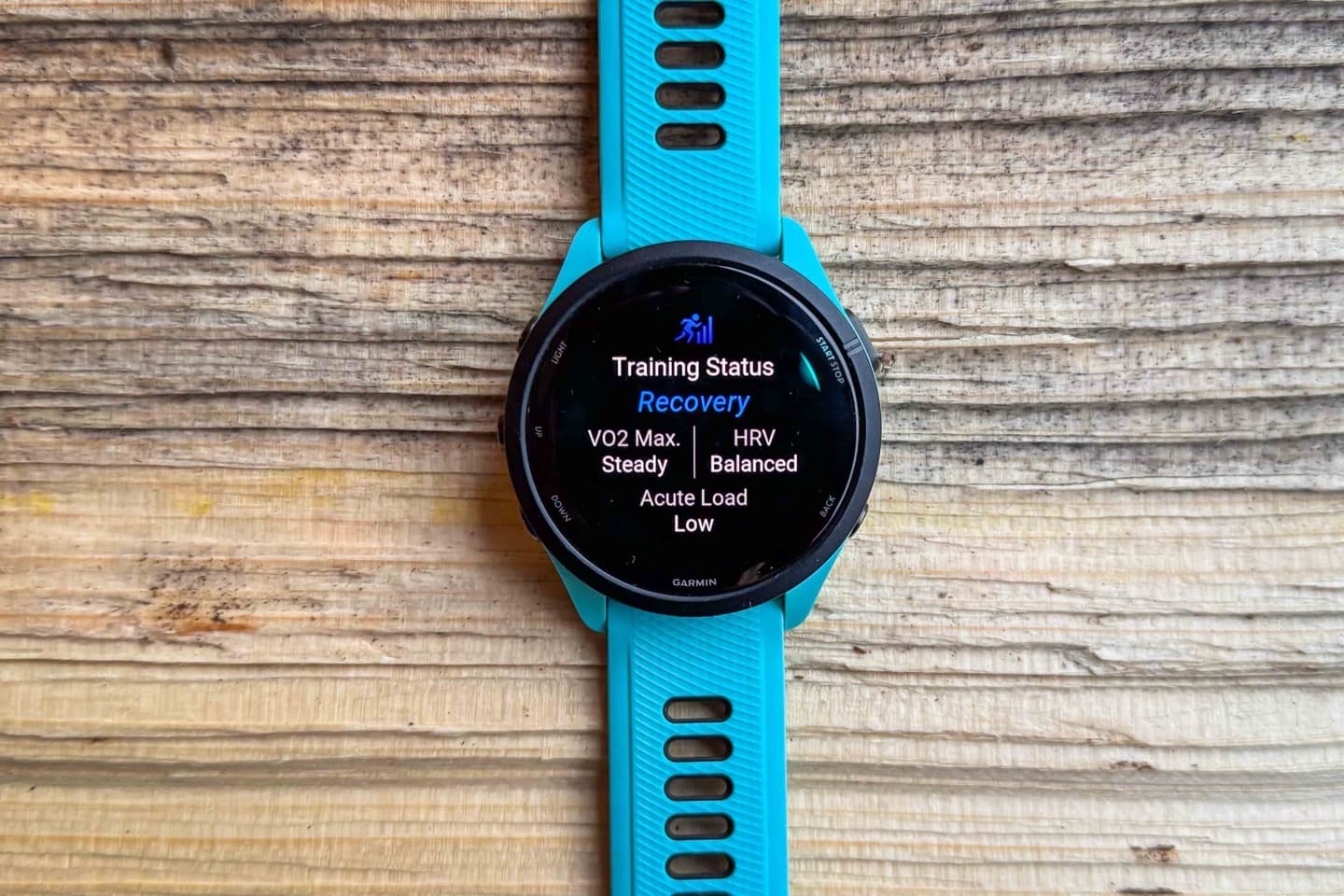
Now, one of those pieces of Training Readiness, is effectively Training Status, albeit in a different way. Training Status focuses more on the training aspect of your life. The best way to think of Training Status is what your coach would say to you, if they looked at your recent workouts. For example, if you just do interval workouts every single day, your (good) coach would roll their eyes and say “that’s unproductive”, because from a training improvement standpoint you need a more balanced diet.
Garmin made some big changes to Training Status about two years ago when they introduced Training Readiness, and it’s now much more focused on the components of training, rather than other aspects (which now are shifted into Training Readiness).
Training Status is not available on the Forerunner 165, though it is available on Garmin’s Instinct 2 series devices, which are now the same price as the Forerunner 165 Music, at $299.
4) Training Load (including Acute Load/Load Ratio/Load Focus)

Next, a key component to Training Status (and Training Readiness) is Training Load. But this is really multifaceted here. First, there’s the training load you’d see on any given completed activity. That training load is largely driven by heart rate zone time (e.g. higher intensity workouts have more load).
You can see here (left) the FR165 doesn’t have this, but the FR265 (right), does.
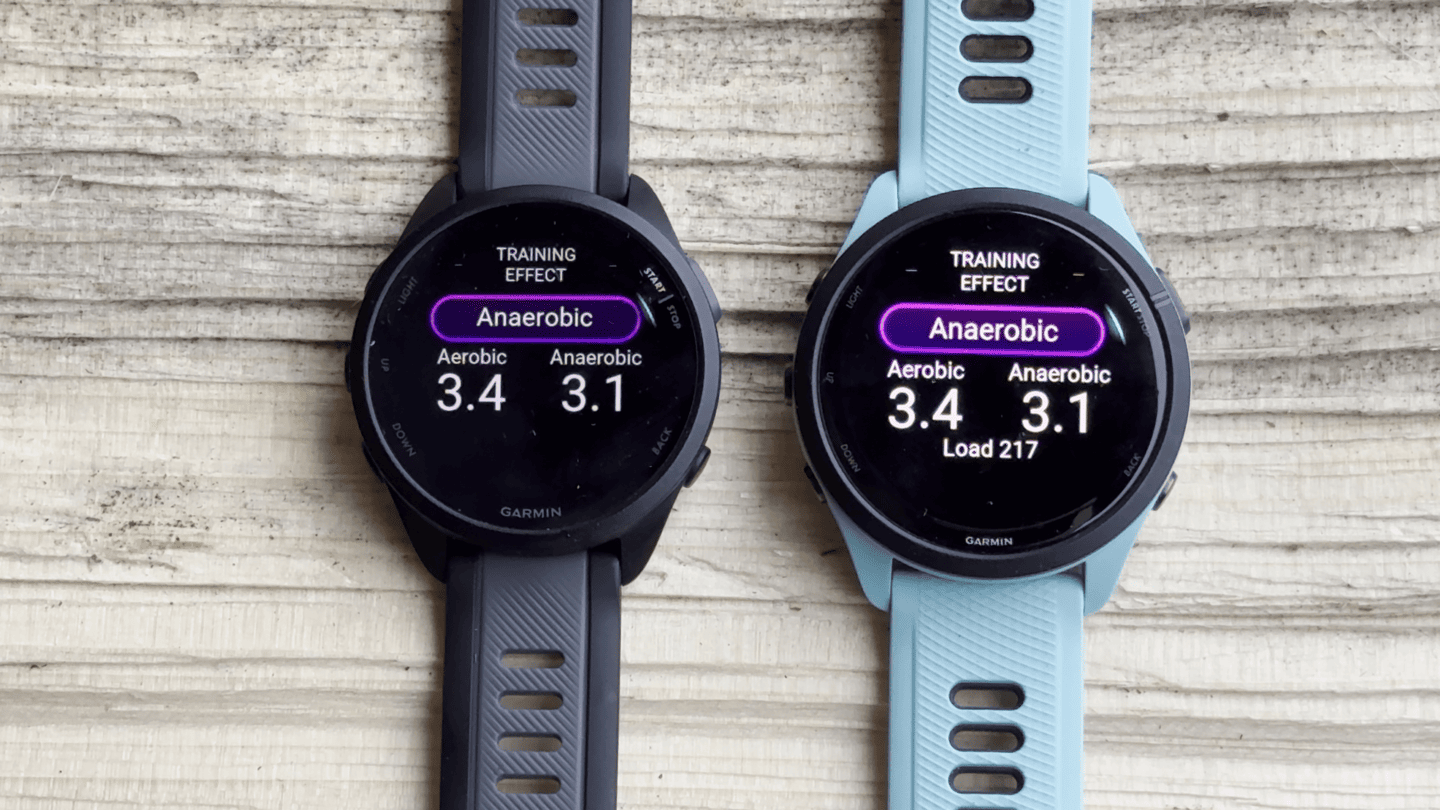
And then from there, that load gets compiled into your total load for both the week and month averages. Your weekly load is called Acute Load, and that too is only on the FR265 (and higher). Acute load though decays a bit, so it’s not a straight total. Meaning that yesterday’s long-run matters more than a run 6 days ago.
In many ways, my acute load from the last 7 days illustrates this super well. I had a bunch of stuff last week, but then I left Friday for a ski trip, where despite many hours of skiing each day, the ‘Workout Load’ per workout, is actually relatively small, thus the downhill trend.
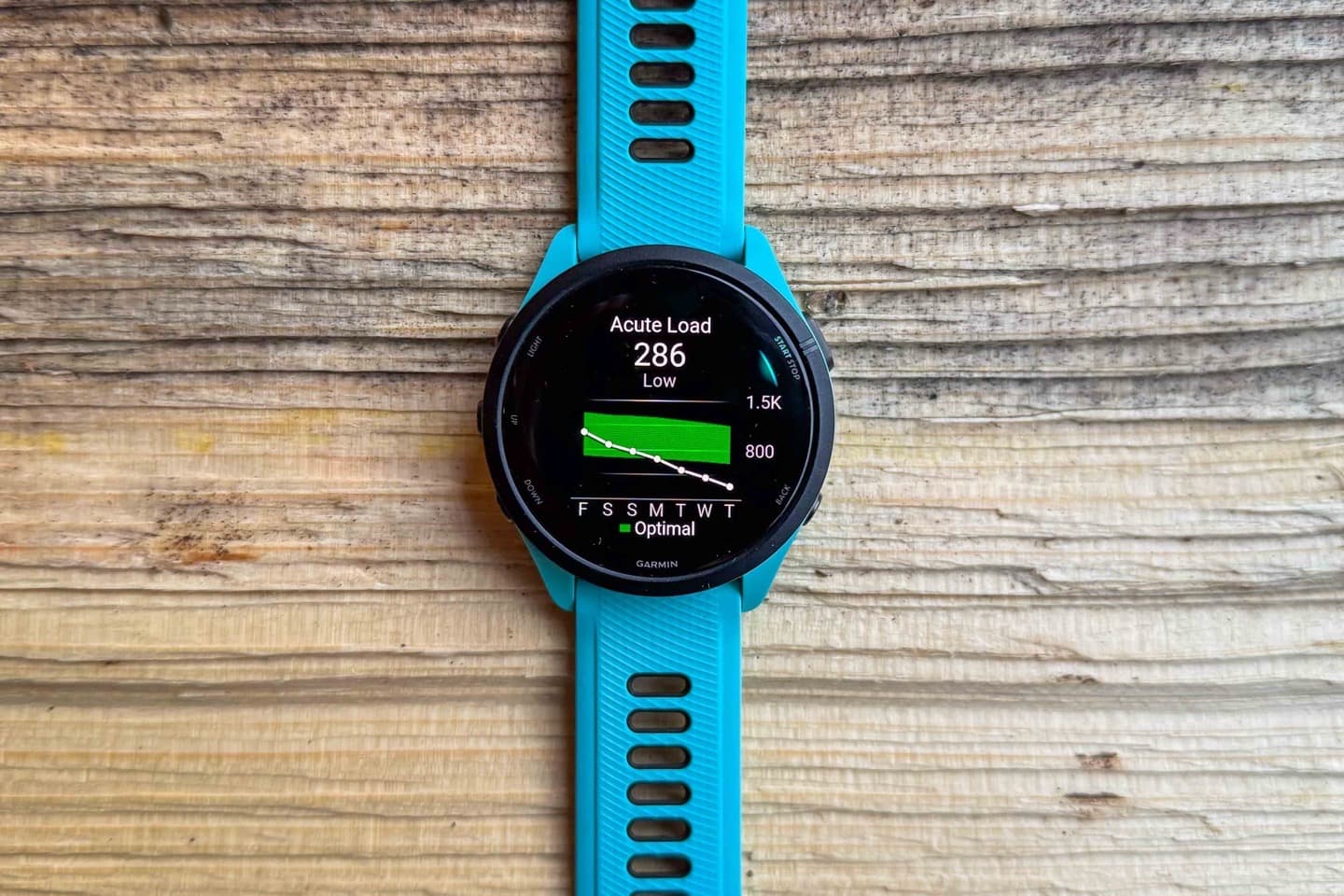
In addition to per-workout load and acute load, there’s also Load Focus, which tells you how balanced your training diet is (e.g., high intensity vs low intensity), as well as Load Ratio (whether or not you’re increasing or decreasing load too fast relative to your history).
Here again, you can see the impact of skiing this week, where my load ratio is super low, compared to my historical norms.
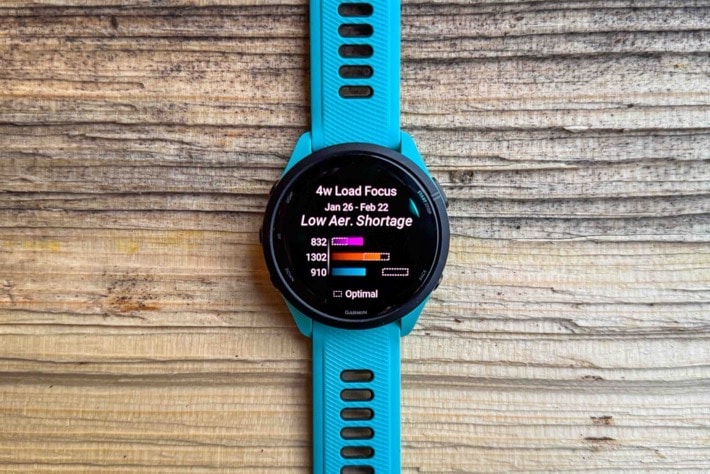
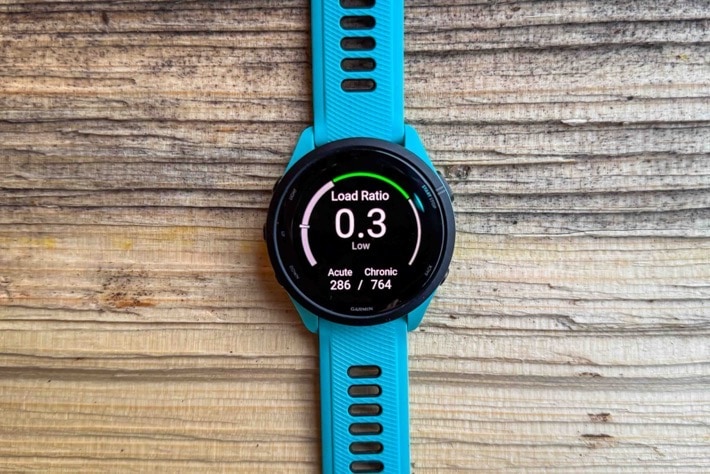
All these Training Load metrics are not available on the Forerunner 165, though they are available on Garmin’s Instinct 2 series devices, which are now the same price as the Forerunner 165 Music, at $299.
5) Triathlon & Multisport Capabilities
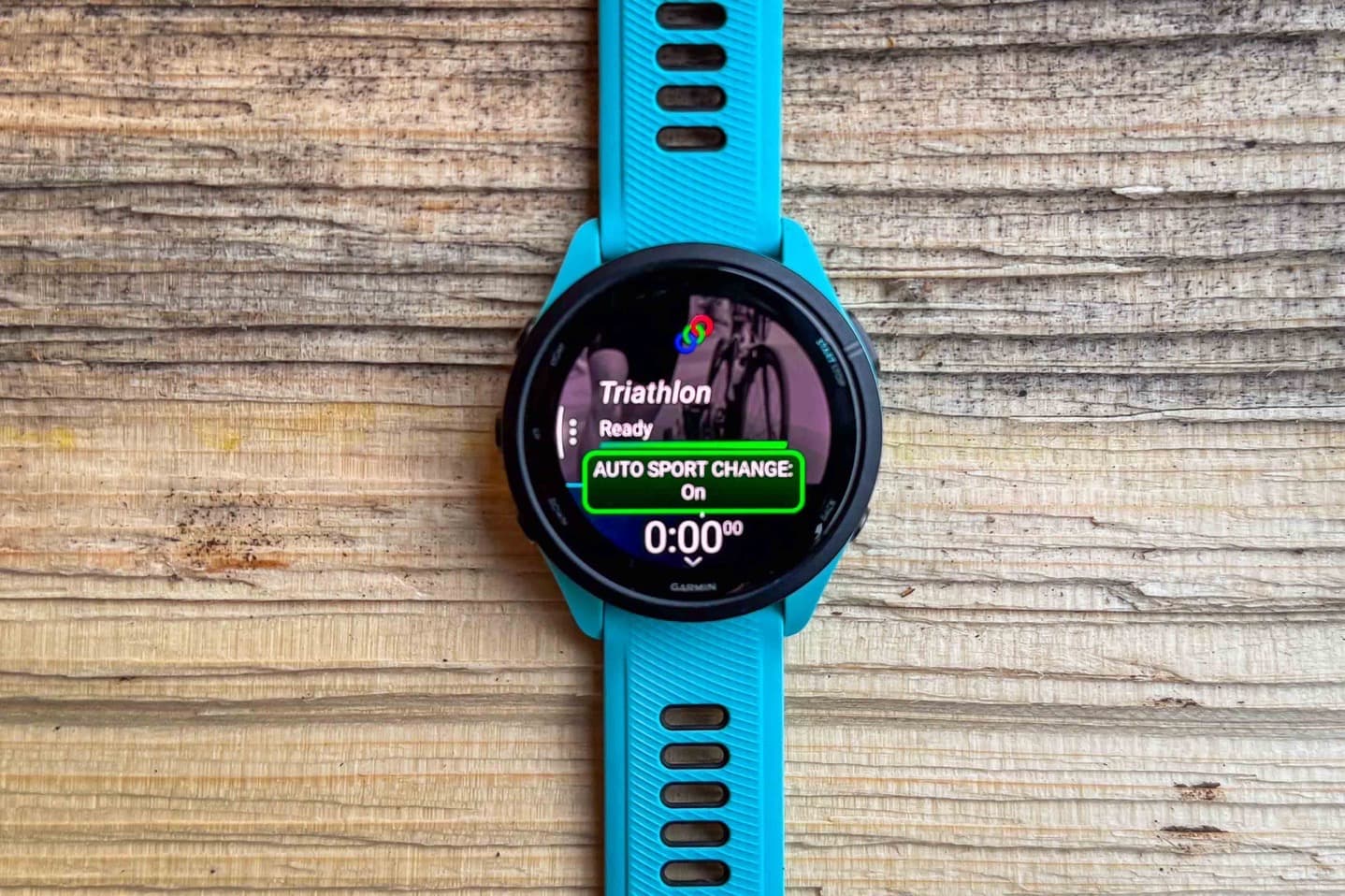
Next, an easy-button one. The Forerunner 165 doesn’t have any triathlon modes, including duathlon and custom multisport modes. An important distinction here is that the Forerunner 165 will individually record all the triathlon parts – but not together as a single workout. Meaning that yes, you can go record an openwater swim. And you can go record a bike ride. And you can go record a run. But you can’t record those as a single cohesive non-stop activity with transition times. The Forerunner 265 can.
Multisport and triathlon metrics are not available on the Forerunner 165, though they are available on Garmin’s Instinct 2 series devices, which are now the same price as the Forerunner 165 Music, at $299. What’s that, you’re starting to see a pattern here, right?
6) Skiing/snowboarding sport profiles:
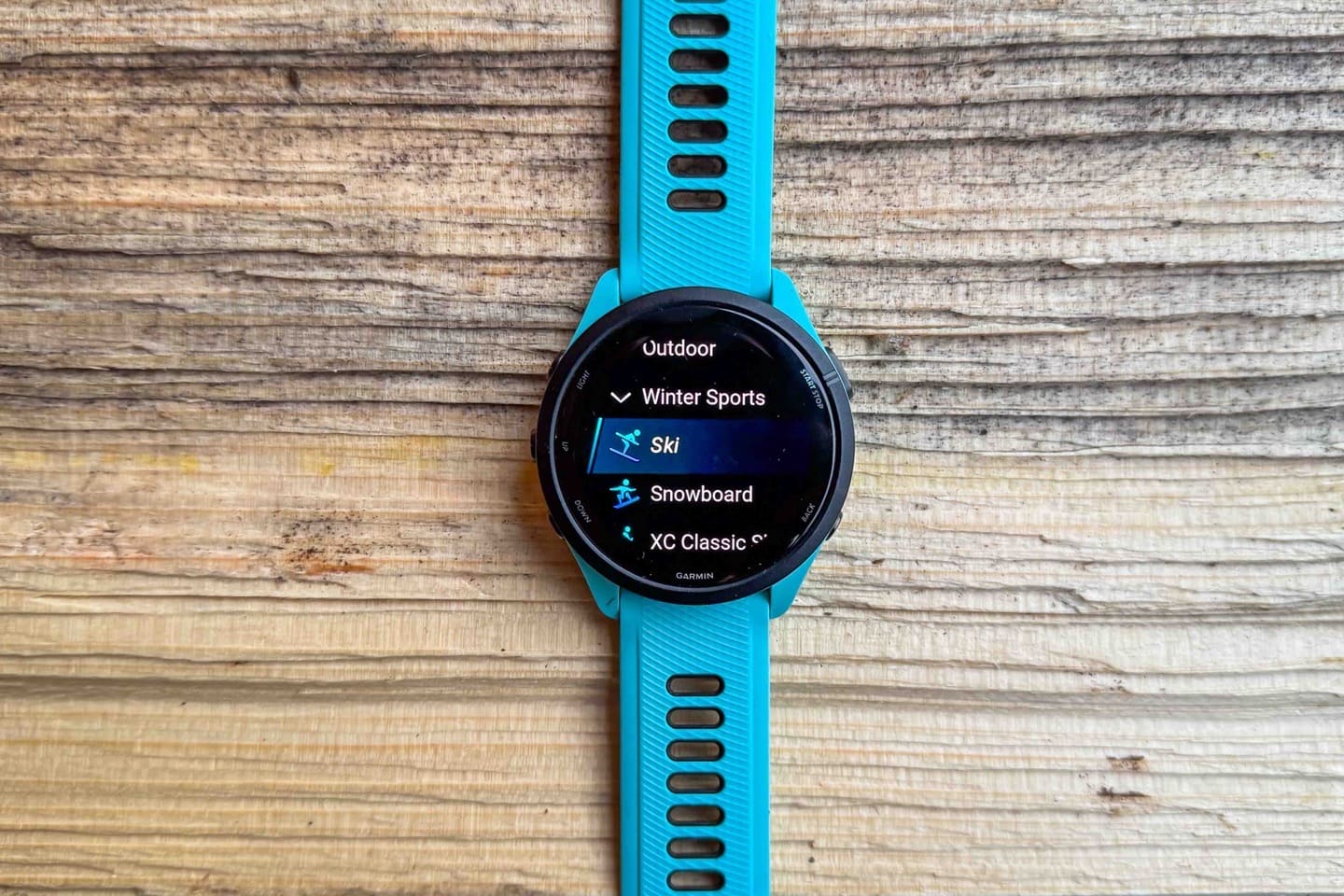
Had this been summer, I might have relegated this to the lower listing of missing sport profiles. But since I’m sitting here at a ski resort writing this post, and had hoped to use this watch to record my runs, I…well…can’t.
Thus, I’m calling out the complete and total wonkiness of this. The Forerunner 165 doesn’t support any ski modes (downhill or otherwise), which is weird given the Venu SQ 2 at the same price supports it. Garmin’s Vivoactive 5 at the same price supports it. And frankly just about every other older Garmin watch they now sell at, or well below, these prices support it.
So, if you wanted to go skiing, you’ll need to choose something else. At least until they add it here…which, I sincerely hope they do.
Skiing and snow sports modes are not available on the Forerunner 165, though they are available on Garmin’s Instinct 2 series devices and basically everything else Garmin makes, which are now the same price as the Forerunner 165 Music, at $299.
6) Power Meters, Smart Trainers, and Other Sensors
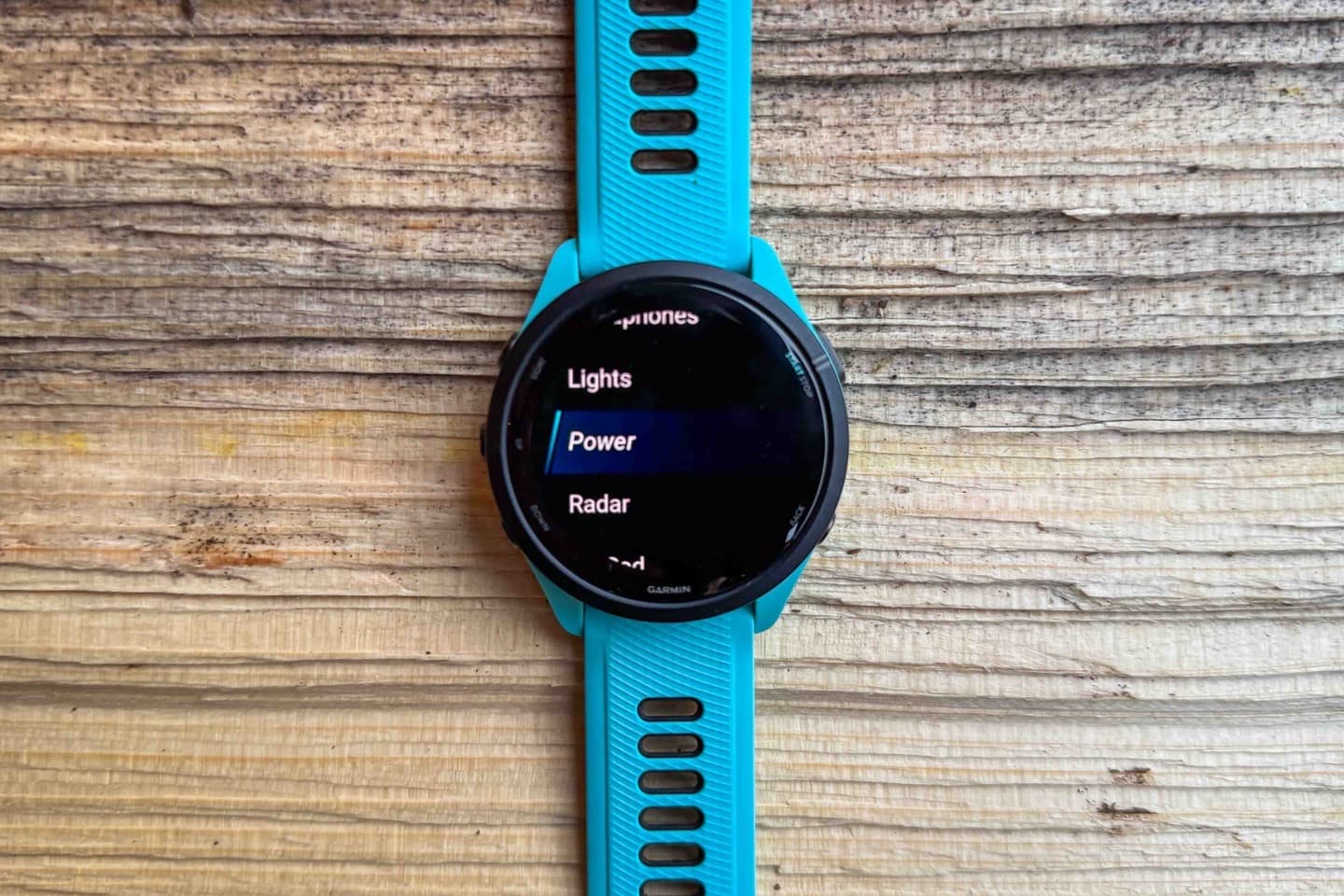
The Forerunner 165 lacks a number of sensor accessory types, but the most notable one is the lack of cycling power meter connectivity. Aside from the skiing bits, this to me is arguably the quirkiest one of this entire list, given that Apple introduced cycling power meter support last summer to their equally priced watches, and Garmin also has it on the Instinct 2 at $299, and heck, even has various sub-$200 bike computers which support it.
In any case, it’s not there today, nor are a bunch of other sensor types. Here’s the key ones missing from the Forerunner 165, that are found on the Forerunner 265:
No power meter sensors (ANT+/Bluetooth), no eBike sensors (ANT+), no Extended Display connectivity (ANT+), no Running RD pod support (ANT+), no Smart Trainer connectivity (ANT+), no VIRB connectivity (ANT+)
Note that, technically speaking, the RD one doesn’t matter too much, since the watch does Running Dynamics natively.
As above, all these other sensors are not available on the Forerunner 165, though they are available on Garmin’s Instinct 2 series devices, which are now the same price as the Forerunner 165 Music, at $299. By now you’ve probably realized that I’m just stirring the pot. It’s my specialty.
7) A Boatload of Sport Profiles

There’s a lot of sport profiles now available on the Forerunner 165, that aren’t available on the Forerunner 265, some 37 additional ones specifically. Note that Garmin is constantly adding new sport profiles, especially to the Forerunner 265. Thus, this list is as of February 22nd, 2024, using the current public beta, which includes more new profiles that are set to hit production in the coming weeks.
Here’s the total Forerunner 165 list:
Run, Track Run,Treadmill, Virtual Run, Indoor Track, Trail Run, Ultra Run, Hike, Walk, Walk Indoor, Bike, Bike Indoor, Pool Swim, Open Water Swim, Cardio, Tennis, Pickleball, Padel, Strength, Yoga, Pilates, Breathwork, HIIT, Floor Climb, Elliptical, Stair Stepper
And here’s the total Forerunner 265 list:
Run, Track Run, Ultra Run, Trail Run, Virtual Run, Indoor Track, Treadmill, Hike, Walk, Walk Indoor, Bike, Bike Indoor, MTB, eBike, eMTB, Pool Swim, Open Water Swim, Triathlon, Multisport, Row Indoor, Strength, Cardio, HIIT, Yoga, Pilates, Elliptical, Stair Stepper, Floor Climb, Boxing, Mixed Martial Arts, Jump Rope, Archery, Inline Skating, Ski, Snowboard, XC Classic Ski, Ice Skating, SUP, Row, Field Hockey, Ice Hockey, American Football, Lacrosse, Rugby, Cricket, Softball, Baseball, Basketball, Volleyball, Soccer/Football, Ultimate Disc, Tennis, Padel, Table Tennis, Platform Tennis, Pickleball, Squash, Racquetball, Badminton, Breathwork, Other
I could mention again that the Instinct 2 series has most of these, but honestly, in this case, that’s an entirely different list. Some overlap, some not, probably always changing.
8) Dual-Frequency GPS/GNSS & SatIQ
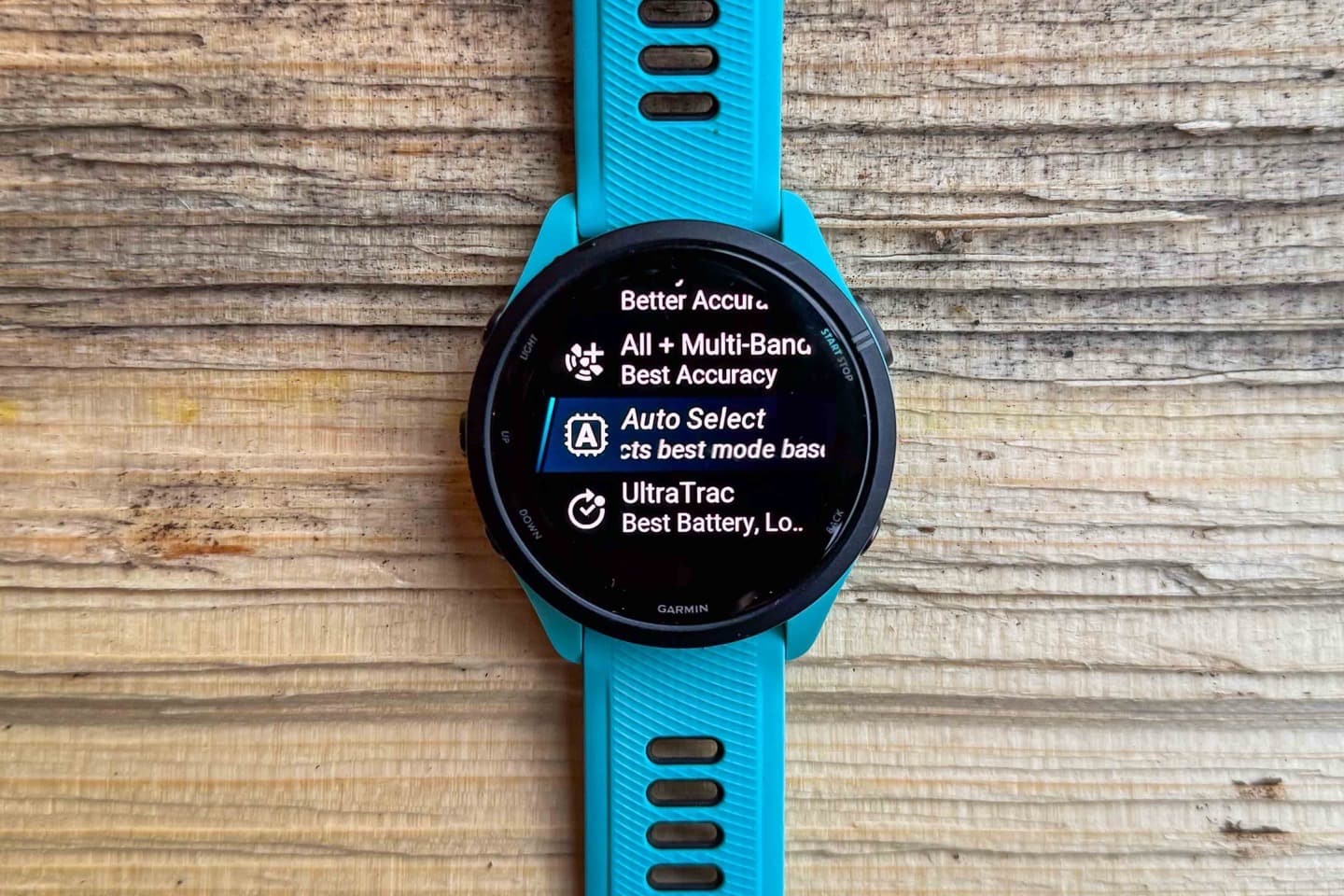
The Forerunner 265 series has multiband (dual-frequency) GNSS systems. That type of GPS connectivity means that in really tough situations, GPS can connect to a different set of satellite frequencies, that can sometimes assist.
And while that sounds really appealing (and it can be), the reality is that Garmin is likely using the exact same chipset (just without the extra antenna bits). And, as we’ve seen over the last little while – or even in the Forerunner 165 review, the GPS accuracy of the Forerunner 165 is incredibly good. It’s matching and even beating other companies’ multiband/dual-frequency watches from an accuracy standpoint. I dive into this quite a bit in my review in the GPS accuracy section.
But the long and the short of it is, that unless you live in Manhattan and specifically run between the crazy tall buildings there, it’s unlikely you’ll see a big difference (if any in fact), between the two units. And, as I showed with even 30-story buildings in the review, there was no difference.
Finally, note that the Forerunner 265 series has Garmin’s SatIQ technology, which lets it automatically switch from multiband to not-multiband dynamically, based on conditions. Basically that saves a bunch of battery life, since multiband consumes more battery life. But given the FR165 doesn’t have multiband, it’s not really applicable here.
9) Battery Life
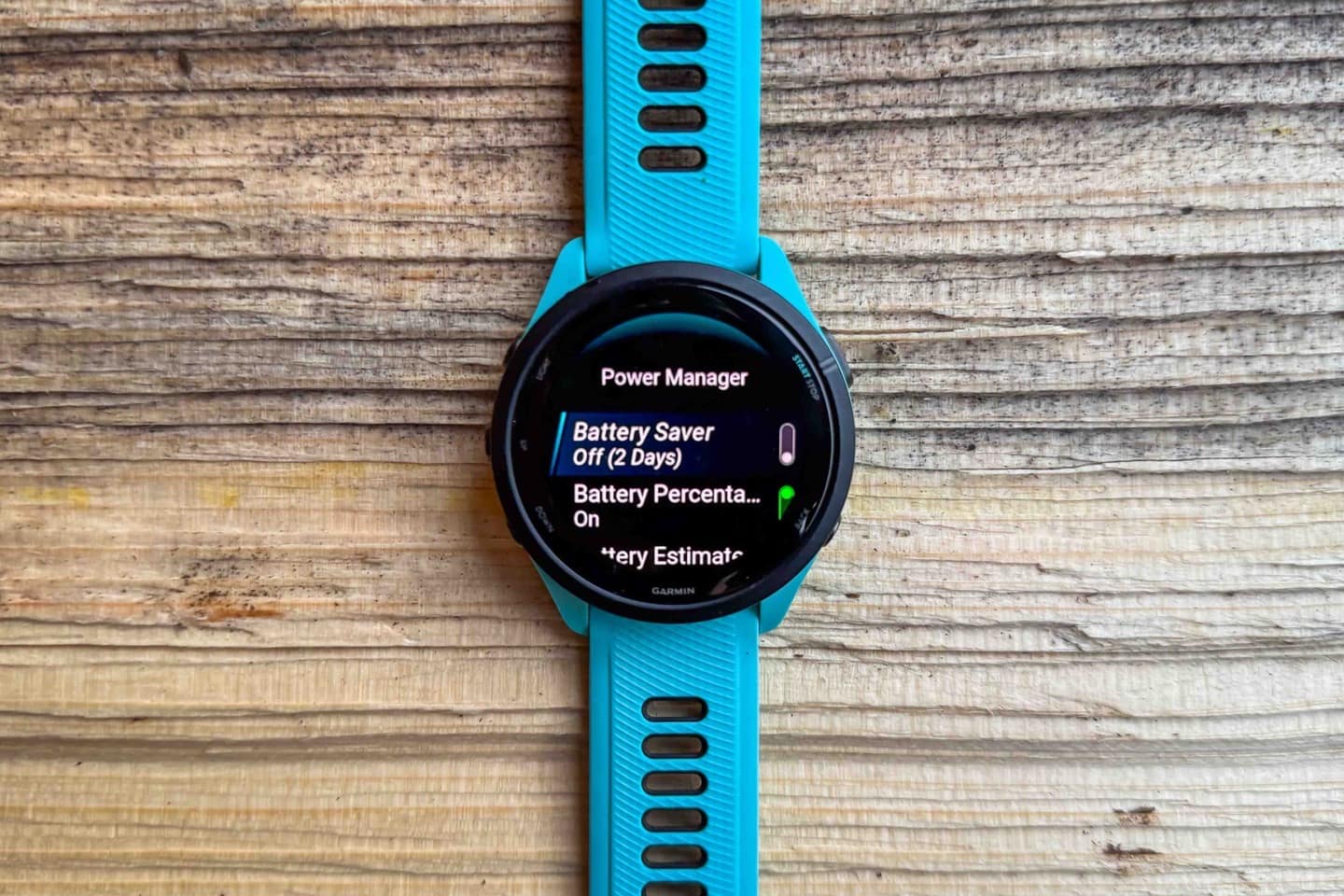
Finally, on the big ticket items, we’ve got battery life. I’ll list all the official claims below, but will simply note that in my testing, I found Garmin’s claims pretty much spot on (if, actually a bit conservative). For those smartwatch times, my testing included 1-2hrs of workouts per day (usually GPS/outside workouts), and it still hit those numbers.
Forerunner 165 Battery Specifications:
Smartwatch mode: Up to 11 days (4 days always-on display)
Battery Saver Smartwatch mode: Up to 20 days
GPS-Only GNSS mode: Up to 19 hours
All-Systems GNSS mode: Up to 17 hours
GPS-Only GNSS mode with music: Up to 7 hours
All-Systems GNSS mode with music: Up to 6.5 hours
Forerunner 265S Battery Specifications:
Smartwatch mode: Up to 15 days (5 days always-on display)
Battery Saver Smartwatch mode: Unspecificed
GPS-Only GNSS mode: Up to 24 hours
SatIQ (AutoSelect) Mode: Up to 18 hours
Multiband/Dual Frequency GNSS mode: Up to 15 hours
GPS-Only GNSS mode with music: Up to 7.5 hours
SatIQ (AutoSelect) mode with music: Up to 7 hours
Multiband/Dual Frequency GNSS mode with music: Up to 6 hours
Forerunner 265 Battery Specifications:
Smartwatch mode: Up to 13 days (5 days always-on display)
Battery Saver Smartwatch mode: Unspecified
GPS-Only GNSS mode: Up to 20 hours
SatIQ (AutoSelect) Mode: Up to 16 hours
Multiband/Dual Frequency GNSS mode: Up to 14 hours
GPS-Only GNSS mode with music: Up to 7 hours
SatIQ (AutoSelect) mode with music: Up to 6.5 hours
Multiband/Dual Frequency GNSS mode with music: Up to 6 hours
And yes, the smaller Forerunner 265S does indeed get longer battery life than the larger Forerunner 265. That’s because they use the same battery in both, but the larger display of the larger FR265 draws more power, and drains the battery a bit faster.
All The Small Differences:
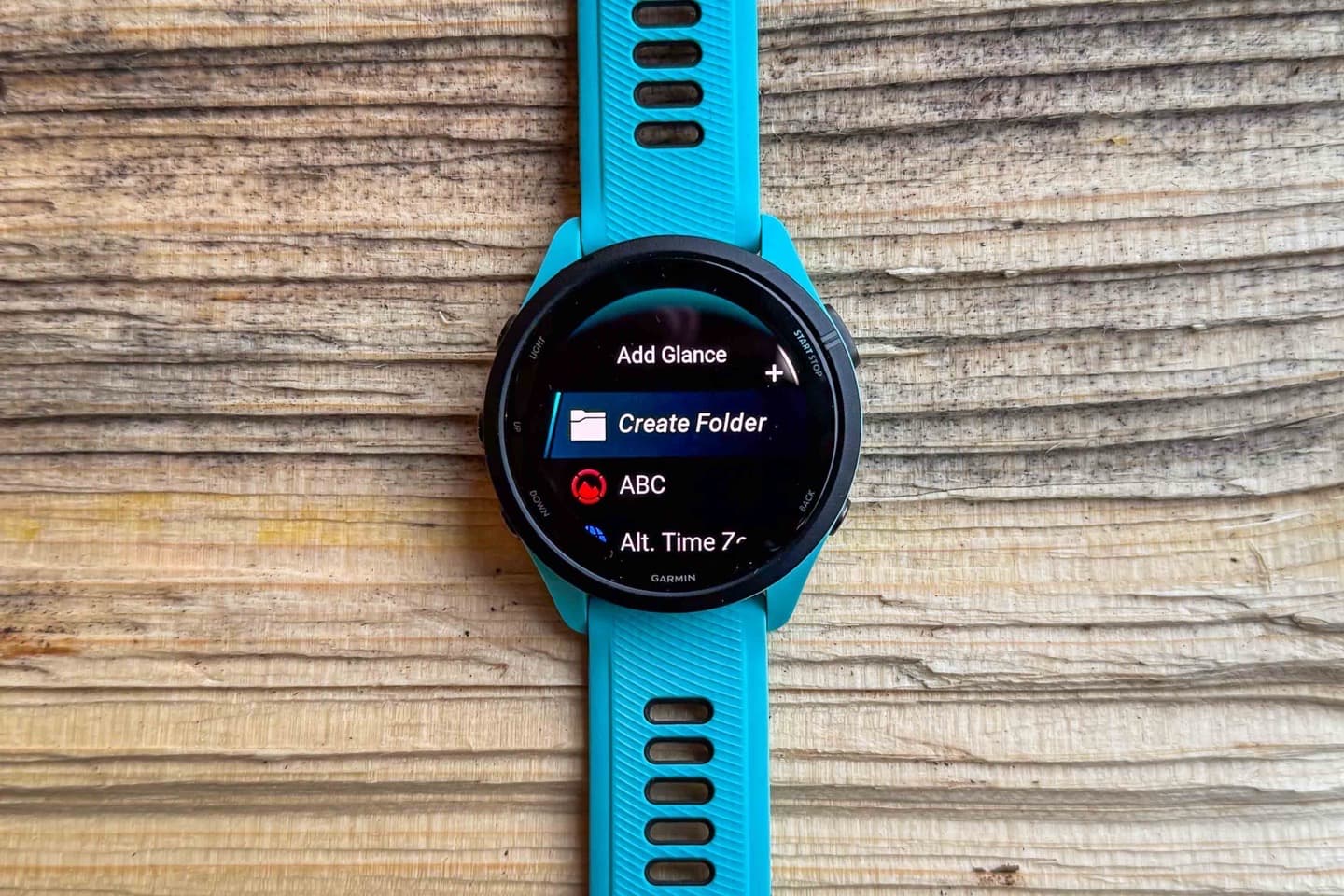
As I noted before, things tend to get out of hand pretty quickly around these parts when it comes to minor differences. The problem is, that some of these differences are actually important for different people. As I often say, one person’s “most important feature ever” is often another person’s “never used it even once”. Thus, while I don’t think the below list is a dealbreaker for most people, it can still be useful.
These are all features the Forerunner 165 does not have:
– Forerunner 265 has the new ‘Lap Undo’ feature
– Forerunner 265 lets you create organizing folders for widgets/glances
– Forerunner 265 currently has Sleep Coach, but the FR165 does not. However, Garmin says it’s coming to the Forerunner 165 in a firmware update , but I just wanted to call that out for now.
– Forerunner 265 has the ABC widget (Altimeter/Barometer/Compass)
– Forerunner 265 has an Altimeter quick-access button
– Forerunner 265 has a Barometer quick-access button
– Forerunner 265 has a Compass quick-access button
– Forerunner 265 has ability to calibrate altimeter
– Forerunner 265 has RedShift mode
– Forerunner 265 has Training Readiness Morning Report option
– Forerunner 265 has barometer alerts
– Forerunner 265 has the ability to set the Voice Prompt alerts to either Male or Female, the FR165 can’t change that setting
– Forerunner 265 has Critical Swim Speed metrics/settings
– Forerunner 265 has cycling power zones/settings
– Forerunner 265 has XC Ski power zones/settings
– Forerunner 265 has Max HR Zone detection
– Forerunner 265 has lactate threshold detection (running, with chest strap)
– Forerunner 265 has dedicated navigation data screens (data pages that only show up with a course/navigating loaded)
– Forerunner 265 has the heading “bug” option
– Forerunner 265 has navigation alerts and options for: Final Distance, Final ETE, Off Course, and Turn Prompts
– Forerunner 265 has the ability to turn off vibration alerts in one shot/setting, whereas FR165 requires multiple settings
– Forerunner 265 has the ability to turn off touch during sleep entirely, though that seems duplicate with the ‘General Use’ option the FR165 doesn’t have.
– Forerunner 265 has dedicated automatic Do Not Disturb timeframes, however that’s mostly duplicate with automatic sleep mode timeframes on the FR165. Plus you can always manually toggle DND mode.
– Forerunner 265 has performance condition (an alert that pops up about 5-10 minutes into your workout, letting you know how recovered you are)
– Forerunner 265 has the running Metronome feature
– Forerunner 265 has the Auto Climb option (when ascending, it’ll automatically add a set of customizable data pages)
– Forerunner 265 has 3D Speed and 3D Distance options (basically slightly more accurate in very steep scenarios)
– Forerunner 265 has auto scroll option
– Forerunner 265 has ‘Record Temperature’ option
– Forerunner 265 has dedicated compass data page for sport profiles
– Forerunner 265 has a slate of compass data fields you can put on custom data pages
– Forerunner 265 has a slate of extra data fields for barometric pressure and a barometric pressure chart, plus training load data fields
– Forerunner 265 supports up to 8 data fields per page, versus max 4 data fields per page on FR165
– Forerunner 265 lets you add specific structured workout data fields to custom data pages (FR165 just gives you a standard structure workout data page)
– Forerunner 265 lets you ‘Race an Activity’ to race past activities
– Forerunner 265 has guided Lactate Threshold test feature
– Forerunner 265 has a curved glass, versus the FR165 doesn’t
– Forerunner 265 has muscle map (in strength workouts), the FR165 doesn’t
– Forerunner 265 probably has more features that I haven’t found yet, somehow.
Oh, and there’s exactly one feature that I found that the Forerunner 165 has, but oddly the Forerunner 265 doesn’t:
– Forerunner 165 has Walk incident (fall) detection, somehow the FR265 doesn’t
With that, my work is done here. As always, I failed in my quest to keep things simple. Many hours later, I regret my choices deeply. Hopefully though, it’s still useful for you.
Thanks for reading!
Found This Post Useful? Support The Site!
Hopefully you found this review/post useful. At the end of the day, I’m an athlete just like you looking for the most detail possible on a new purchase – so my review is written from the standpoint of how I used the device. The reviews generally take a lot of hours to put together, so it’s a fair bit of work (and labor of love). As you probably noticed by looking below, I also take time to answer all the questions posted in the comments – and there’s quite a bit of detail in there as well.
If you're shopping for the Garmin Forerunner 165 or Garmin Forerunner 265 or any other accessory items, please consider using the affiliate links below! As an Amazon Associate I earn from qualifying purchases. It doesn’t cost you anything extra, but your purchases help support this website a lot.
And finally, here’s a handy list of accessories that work well with this unit (and some that I showed in the review). Given the unit pairs with ANT+ & Bluetooth Smart sensors, you can use just about anything though.
And of course – you can always sign-up to be a DCR Supporter! That gets you an ad-free DCR, access to the DCR Shed Talkin' video series packed with behind the scenes tidbits...and it also makes you awesome. And being awesome is what it’s all about!
Thanks for reading! And as always, feel free to post comments or questions in the comments section below, I’ll be happy to try and answer them as quickly as possible. And lastly, if you felt this review was useful – I always appreciate feedback in the comments below. Thanks!

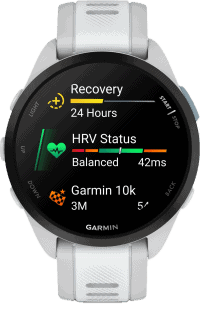
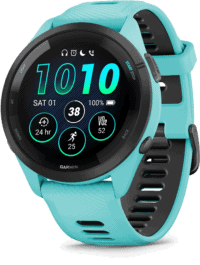
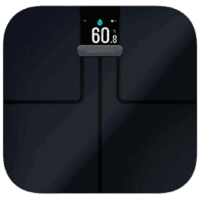
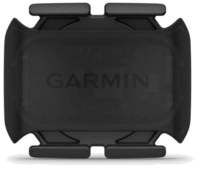
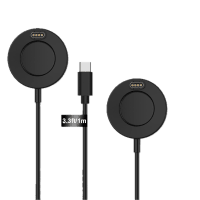


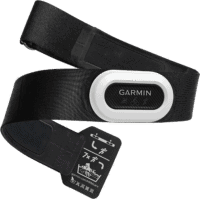



















Great summary,
As a Forerunner 245 owner it’s amazing how far the base model has come (I think it has almost every feature than my 245 does) and how much the 2xx series has added in 2 generations. Will be a tough choice when I next upgrade.
Garmins decision to not support power meters in this watch is indeed quirky. Especially when you consider how common spin bikes with power meters are in the gyms today. Anyone nerdy enough to get a sport watch would certainly like to register spinning classes with power meter if the bike has it. The watch should not be restriction in this case.
Regarding GCT balance: I have a 255 and an hrm pro and it does GCT balance. No néed for an RD pod…
Not that I would care about it though.
Good catch!
…the sports profile is not an issue. Simply just record an activity as Running, even if it is skiing and after uploading to Garmin Connect you can change the activity type there…
Except that’s not the skiing profile. The skiing sport profile automatically counts your runs, figures out when you get on/off the chairlift, and tracks things like max speed and descents per run.
I’ve found your reviews very interesting despite not being an athlete at all. I wish there was a viable way for Garmin to serve different price points without all the random bundling of hardware and software features. I.e. being able to mix-and-match software options with hardware variant.
I bought the FR 255 (non-music) last year as a compromise to get a daily wear watch with basic health/fitness tracking (steps, sleep, HR, etc) and the ability to track walks and hikes. It is overkill in terms of sports functions but a decent physical package for me. I disabled most of the athlete-focused functions to simplify the UI for me. I’ll probably never use the running modes much less any of the multisport functions. And yet it still annoys me slightly that it lacks the snowshoe activity even though it’s literally just walking with more drag.
It sounds like the Instinct 2 or the FR 165 both have the features I actually use, except I don’t understand what the ABC limitations are in the FR 165. It doesn’t make sense to not be able to calibrate the altimeter…?
But I find the physical packages of both the Instinct 2 and the FR 165 to be a worse choice for me than the FR 255. I’m a big fan of the simple, clean FR 255 case and MIP screen. I like the always-on MIP screen’s battery life and dislike the weird shape and resolution of the Instinct screens. I also see little value in the touch screen nor phone linking.
It seems like I may not have any good options for me in the future when I need to replace the FR 255 for my purposes.
One more important difference IMHO is the memory: 265 has 8 GB vs 165 has 4 GB. Can be of importance for Spotify or podcasts or other apps I guess.
Another difference of importance might be the HR sensor: 265 has Elevate 5 vs. Elevate 4: might have an influence on HR accuracy or future features.
Having the 265s I do not believe software features like training readiness are worth it: I was sick and the 265 suggested me to go running?? The HRV was clearly trending low nevertheless …
I have yet to find a Garmin watch with the perfect set of features for me. Getting into the weeds of each watch inevitably leads to disappointment. So I am tempted just to give up on smartwatches entirely. Why spend good money for a watch I dislike before I buy it?
They both have Elevate Gen 4 sensors – only Venu 3 series, Epix 2 Pro series, and Fenix 7 Pro series have the Gen 5 elevate sensors.
Indeed, my mistake: both have Elevate 4. One reason less to go for FR 265.
The short answer here is- if you read DCrainmaker reviews, and are an avid endurance athlete… this watch isn’t for you. And really, you also need maps… so just get the 965.
Not always true. I read DCR, work in tech, and I’m a reasonably competitive runner…and I rock the FR55 and it’s great. It has all the features I need.
Honestly, this has all the features an avid (running) endurance athlete would want. I say this as a person who enjoys the additional metrics, enjoys not charging for a week+, does ultra marathons. I personally want all the other features, but I’m mostly kidding myself if I think training status and load actually impact my training in a substantial way.
And you can always see training status/load in the Garmin app, right? Or isn’t that the case?
It should only be enabled if there’s a compatible level device on the account (e.g. if you had a cycling device that supported load, then it’d show it).
Thanks for the quick reply Ray. I indeed have an Edge 840. So I would see the impact on training load of the efforts recorded by the FR165 in the Garmin app then?
Yup, correct!
Thanks, good to know. I’m using the edge 1040 and the Vivoactive 3 and was wondering why things are visible in Garmin Connect like Training Status. Is it right, if I don’t need the Readiness feature, just a better analysis of sleep, hrv and etc and being a cyclist with no need of multisport feature the 165 would be the best value for more insights health-wise? (SUP support is missing, sleep coach would be nice, maybe with a n update?…) Thanks.
I am considering downgrading from the FR 245 to FR 165. If I maintain my FR 245 in Garmin Connect, will Training Load/Status be visible in Garmin Connect when I exercise with the FR165?
I’m responding to my own question: Indeed, that works.
What can you say about the glass? Is it similar/better/worse than Gorilla? That’s actually the only point that unsettles me. I have the FR245 and a change would really be worth considering due to the barometer, GarminPay and touch display. The FR265 is too expensive for me. The FR965 anyway.
It’s hard to know for certain, but I’m pretty sure Garmin uses this same stuff on numerous other devices for a long time, without issue.
For the most part, I don’t see any meaningful difference between these display types, and likewise, I don’t see any big difference in complaints (virtually none) either.
I would invest the extra money on a MIP display, but never on Amoled. I find they’re kinda disposable. The 165 seems much better value.
Does the 165 round lap pace (in track mode or in general)?
Thanks!
“Forerunner 265 has the running Metronome feature”
Wow! I was going to get the 165 coming from an aging 645 Music, and not thinking that I needed any of the higher end features. But lack of metronome would have really annoyed me. Their segmentation is so annoying!
Thank you for yet another great review! I’m in the process of buying a new watch from the forerunner-series and am leaning more towards the forerunner 265S for several reasons.
With a multiple of new watch-releases this year (read 2024), I was wondering if Garmin might make some adjustments to their prices of earlier released watches, especially the FR265S? Has Garmin been likely to do so previously?
Hey. Thanks for all your work. Love you reviews.
One small question.
I currently have a 245 and use glass screen protectors. I break them quite often while rock climbing. I would have wrecked the screen many times if it had raised glass like the 265. Big con for me to buy it.
The 165 is flat glass.
Do you think garmin might move to flat glass again or might it just be on the cheaper watches?
Thanks again. 👍
In the Youtube Video, in the minor differences list it states that the 265 has Nacho Cheese Dispenser at about 9:45 into the video. I can’t find any additional information on that feature, can anyone elaborate? I’ve always wanted a Nacho Cheese Dispenser integrated into my sports watch.
The Forerunner 165 apparently emits audible beeps to signal upcoming turns; but does it also have arrows on the display to visually alert about upcoming turns? I think that the Pace 3 has visible arrows, but am unsure about the 165.
The list of sport profiles for the 265 above includes XC Classic Ski but not XC Skate Ski, which my Fenix 6 Pro has. It is not in the list for newer watches on the Garmin web site either. Is it not supported any more?
I show it on the Epix Pro & Fenix 7 Pro series (with current firmware).
Hi,
You mentioned in one of the video’s that you do not wear two watches on the same wrist to avoid interference. How do you know this happens? How can you see in the data that this happened? Is this interference via Bluetooth or wat?
Many thanks and with kind regards
No prob. It’s specifically interference at the heart rate, and activity tracking realm. There’s also minimal possibility of GPS interference, from blocking the antenna ‘view’ by another watch directly next to it.
In terms of heart rate, that can be impacted two ways:
A) If one watch is rather snug/tight, it can impact the blood flow measurement of the next downstream watch.
B) More importantly though, if one watch is bouncing/touching each other, it’ll cause scenarios that might make one or both watches think that’s the heart rate itself, since at a very high level, the ‘loudest’ thing closest to the sensor will win (over optical). I say ‘loud’, because we’re talking vibrations, and specifically repetitive vibrations that would match that of a heart rate (such as a stable running cadence).
Lastly, on the activity tracking side (e.g. steps), this exact same concept applies, but to the counting of steps.
Oh, and finally, wearing two watches side by side typically pushes one watch slightly too high, and one watch too low. Too low means it’s likely over your wrist bone, which very much a not-good place for optical HR. And too high can often mean it’s in a spot where you probably had to loosen the strap to slide it further up the arm, but often, this will cause it to ride back down over the top of the next watch, increasing the optical HR gap to skin under the upper watch (thus decreasing accuracy).
To use a bad analogy, think of it this say: You can tie two cars together side by side and drive down the highway. But, there’s a heck of a lot of bad things that can happen along the way, both minor things (scrapping each other), and major things (epic crashes). :)
Thank you for the fast and extensive response.
And so if I understand it correctly, this is the case for two smartwatches on the same arm, but also for a smart watch and a normal watch on the same arm?
Your list on here doesn’t include the Nacho Cheese dispenser. I’m disappointed as that was the biggest selling point from the video…
Hi. I’d be curious to know if anyone has insight on when the Forerunner 275 is likely to be released.
The 265 is currently 12mths old. Time between upgrades varies, going off the below history. Wondering if given the 165 has just been released, whether anything can be read into when the 275 would be coming. I am comfortable with buying the 265 now. Though less so say if a 275 is within 6 months away. Thank you (p.s. currently own 645 from 2018)
265 – Mar 2023
255 – Jun 2022
245 – Apr 2019
235 – Oct 2015
965 – Mar 2023
955 – June 2022
945 – Apr 2019
935 – Mar 2017
Coming from a 645M to a 165M, there are loads of improvements, most notably the screen, GPS accuracy, wrist-based running power and suggested workouts.
The lack of a lactate threshold test is mildly annoying (back to the 645M for that once in a while), but the main downside is that structured workouts use instant pace not step pace, with no ability to change this. If I’d realised this, I might have gone for a 265 so that I could use the customisable workout fields.
Much appreciated Michael. I went ahead and bought the 265. Excited about its arrival :)
Well. I ordered the 265S after a lot of consideration. Ray – thanks for these deep dive reviews. It can be overwhelming when considering the many features on all these different smart watches. I will be leaving my Polar Ignite behind when the Garmin gets here. I finally realized that the smaller size was more my jam – when I got the Polar Ignite when it came out, I got it because the Coros Pace was just too big. I kinda like Polar because of the H10 strap and the other products I’ve had of theirs over the years.
I also realized that if I truly hate the 265S, I can sell it on eBay and come back to reenter the quagmire of information. There is no perfect watch. I imagine I will use just a fraction of the 265S features anyway.
Thanks to you and your wife for sharing the pics of the 265, 265S, 965, and more on your wrists, Ray. That was quite helpful. I think it’s time to delve into the guide you’ve recorded for the 265. Cheers!
Very nice comparison! Which one for open water accuracy? The winner compared to 965?
One specific question, can the 165 pair per ANT+ with a non-Garmin bike computer? I’ve got a Wahoo Bolt 2. Thanks for the reviews!
Great article, great comparison giving great insite. Thank you so much.
This is an excellent summary!! Thank you so much. I am in the market for a watch (unfortunately I lost my FR 265) and I didn’t use all the features so I’m contemplating downgrading to 165. This article confirms my decision!! I now have to take a quick peak at the Samsung watch to see if their latest watch is worth considering before making my final decision :)
I always go to you for reviews. This was confusing where you said the watch doesn’t support ant + accessories certain ones listed but then at the end say pretty much supports any ant+. I have an old running garmin pod that I use on my 965 and want to get this watch for my wife. And share the pod.
I have a garmin 135 which I punched two years ago and i had a crash ad scratched up the watch face is there anyway I can have it replaced? Thanks pat
Hi,
As always, you make great summaries. I have a question regarding distance and speed in 3D. In the area I live in Denmark, it is a little hilly, constantly changing 5 to 10 meters vertically. This means that 100 meters in 2D could be 125 meters in 3D. Are both the Forerunner 265 and 965 capable of measuring the accurate distance in such small vertical variations? And are they both capable of being set up to “every second recording,” which gives a more accurate route due to GPS recording every second?
Wish they’d just simplify and consolidate into fewer models.
I do not understand the fundamental differences between various categories of Garmin Products–e.g., Forerunner, Fenix, Enduro, Instinct Vivo, and perhaps others.
They all seem to cover running, and maybe they all also cover swimming and cycling. So why should I concentrate on one category or another?
If you figure it out, let Garmin know, since I don’t think that they have any idea themselves. They must all sell well, though.
The only line of Garmin watches I have personal experience with is the Fenix/Epix line (Epix is a name they occasionally use for a Fenix with special characteristics). My impression is that Forerunners are designed for running, Enduro for battery life, Vivo is their smart watch equivalent. All you can do is decide what you want the watch do to now or to do in the future if you have the urge to take up golf or downhill skiing or something else. Read/watdh Ray’s and other’s reviews to find one that will do that. In my case, I want a watch for hiking and cross country skiing with maps and navigation, so currently my Garmin watch is an Epix 2. (My daily wear watch is an Apple Watch Ultra, which is a much better smart watch than anything Garmin produces, but pales in comparison to a Garmin watch for sports/activities.) The Epix does everything I want, and can act as a backup for my Edge 1040 (cycling) if suddenly something goes wrong with it. But there are probably other Garmin watches I could use (the highest end Forerunner is usually just a plastic Fenix).